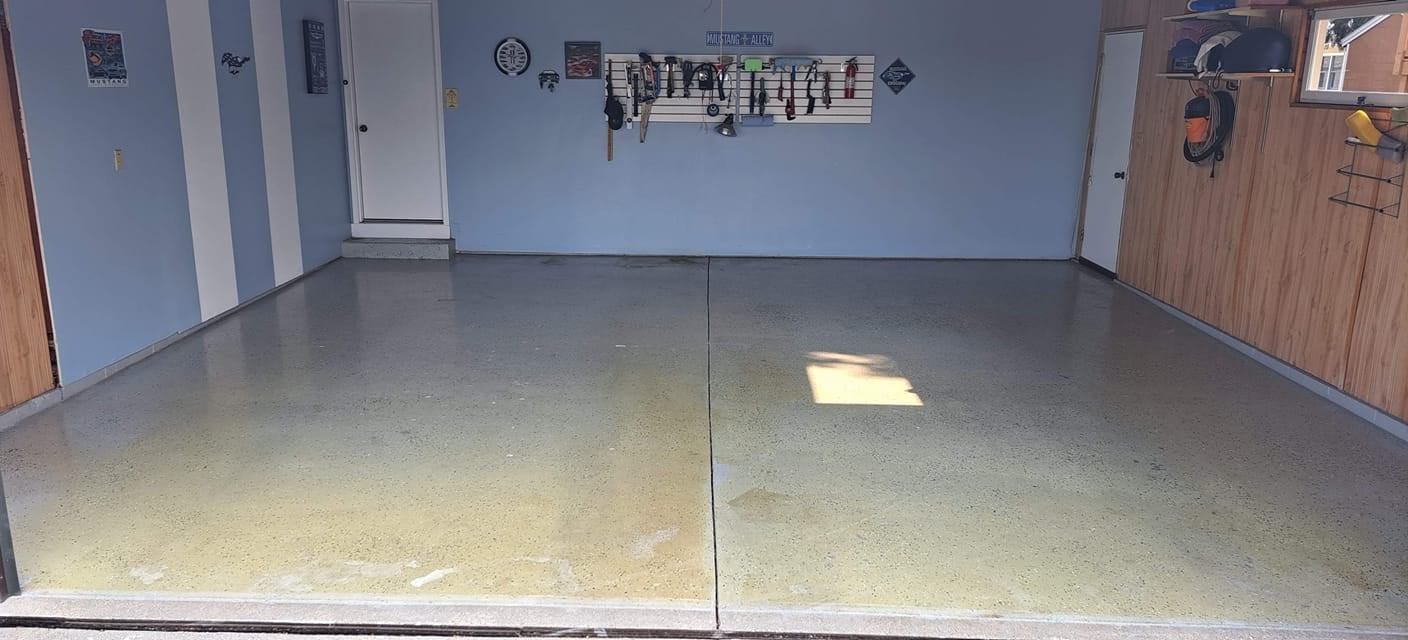Most Common Problems with Polyurea Concrete Floor Coatings
June 25th, 2024 | 3 min. read

Introduction to Polyurea Concrete Floor Coatings
Ever walked into a newly renovated space, admired the sleek, shiny floor and thought, “Wow, I want that for my shop.” But then, you start hearing about things like UV damage, rapid wear, and bubbling issues. It’s enough to make anyone second-guess their choices. At Floor Shield, we know flooring isn’t just about looking good—it’s about lasting quality. That’s why we’re diving deep into the world of polyurea concrete floor coatings to uncover the real story behind their glossy surface.
By the end of this article, you’ll understand not only the challenges but also the solutions, ensuring you make a decision that fits your needs, whether that’s with us or another option.
The Challenge of UV Stability in Polyurea Coatings
What’s the Deal with Sunlight and Polyurea?
Imagine you’ve just laid down a beautiful, shiny polyurea coating on your outdoor patio. It looks fantastic—until the sun beats down on it, day after day. Over time, you notice it starting to yellow and fade. Unlike its cousins, polyaspartic and urethane coatings, which boast excellent UV stability, polyurea will suffer under the sun. This is because polyurea is not naturally UV stable, leading to ambering (yellowing) and degradation if not protected by a topcoat. At Floor Shield, we’ve seen this too often, which is why we recommend a 100% polyaspartic color topcoat for areas exposed to sunlight, ensuring long-lasting brilliance and protection.
Why Choose Polyaspartic Over Polyurea?
Here’s the kicker: while polyurea might be a tad cheaper and easier to install, it doesn’t match up to the UV resistance that polyaspartic offers. This makes polyaspartic a better investment for areas like patios or driveways that get a lot of sun exposure.
Overcoming Application Challenges with Polyurea
Getting it Right the First Time
Applying polyurea might seem straightforward, but it requires a keen eye and steady hand. Why? Because once polyurea hits the floor, you’ve got a very short window to spread it evenly before it begins to set. Miss that window, and you’re looking at uneven surfaces that just scream for a do-over.
Common Pitfalls and How to Dodge Them
Ever seen a floor with tiny bubbles or what looks like blisters? That’s what happens when moisture sneaks into the mix during application. Polyurea’s sensitivity to moisture can be a real spoiler, especially in humid climates or on substrates that haven’t been properly dried.
Cost Comparison: Polyurea vs. Epoxy vs. Polyaspartic Coatings
Breaking Down the Costs
Let’s talk numbers. Initially, polyurea might seem like a cost-effective option compared to polyaspartic coatings. However, when you factor in the longevity and fewer reapplications required for polyaspartic coatings, the cost benefits start to tilt in its favor. For businesses, this means less downtime and more durability, equating to savings over time.
Durability Concerns: Polyurea Compared to Polyaspartic
Not All Coatings Are Created Equal
While polyurea is tougher than most traditional epoxies and can handle a fair bit of wear and tear, it doesn’t hold a candle to polyaspartic coatings when it comes to resisting scratches and scuffs. In environments with heavy traffic or abrasive conditions, polyaspartic coatings provide that extra level of durability that keeps floors looking newer, longer.
Addressing Moisture Sensitivity in Polyurea Coatings
Moisture: The Invisible Enemy
Here’s a scenario: You decide to apply a polyurea coating in your basement where the air is a bit damp. Without proper dehumidification, that slight dampness in the air can cause your new floor to bubble up, leaving you frustrated and facing a potential redo. It’s crucial to address environmental moisture when working with polyurea.
The Double-Edged Sword of Rapid Curing Times
Fast Curing Process
The quick cure time of polyurea can be a blessing and a curse. On the one hand, it means your business can resume normal operations sooner without lengthy downtimes. On the other, it demands precision and speed during application, leaving no room for errors.
The Importance of Professional Installation for Polyurea Coatings
Why You Shouldn’t DIY This Project
While the idea of saving money by applying a polyurea coating yourself might be tempting, the risk of improper installation is high. Professional installers have the training and tools to ensure the job is done right the first time, saving you the headache and potential cost of future corrections.
Conclusion: Is Polyurea Right for Your Flooring Needs?
Polyurea floor coatings offer some fantastic benefits, such as rapid curing times and a tough finish. However, they come with their own set of challenges, like sensitivity to UV light and moisture, and the need for precise, professional installation. If your space receives a lot of direct sunlight and want to optimize the longevity of your concrete coating, a polyaspartic coating might serve you better in the long run.
Choosing What's Best for You
We hope this guide has helped you understand the nuances of polyurea coatings and how they compare to other options on the market. Remember, choosing the right floor coating is about balancing cost, durability, and maintenance needs. If you’re unsure, consulting with a professional can help steer you in the right direction, ensuring you invest in a solution that meets your specific requirements.
If you’d like a free, no-obligation quote for Floor Shield’s 100% polyaspartic concrete coating or have any questions, fill out the form below.
